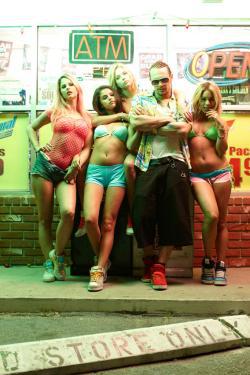There seem to be two critical perspectives on Spring Breakers. Is the veteran provocateur Harmony Korine’s most mainstream movie yet—the story of four college girls who go a little too wild on a party trip to Florida—a dead-on formalist send-up of our of culture’s sick obsession with guns, drugs, and the sexual exploitation of young women? Or is it a stultifyingly dull piece of exploitative garbage?
This false binary misapprehends the central Harmony Korine stratagem, which is to ensure that the viewer can have it both ways. The director of Gummo, Mister Lonely, Julien Donkey-Boy, and Trash Humpers creates objects that are somewhere between movies and performance-art projects. Often deliberately crude in their construction, Korine’s affectless spectacles comment on debauchery, alienation, and sexism by unironically, even lecherously, wallowing in them. You could attend a matinee screening of Spring Breakers with an eye toward either writing your master’s thesis or masturbating. I’m fairly sure there were attendees at the daytime showing I caught with both aims in mind. One guy actually brought a raincoat.
The nubile female bodies you will be watching bounce around in slow motion (at least in the foreground; there are a lot of others behind them) belong to Vanessa Hudgens, Selena Gomez, Ashley Benson, and Rachel Korine. The last of those is the director’s wife; the first three are TV and/or pop stars known for their participation in wholesome Disney entertainments like High School Musical and Pretty Little Liars. So there’s a lot of symbolic reputation-sullying to get through as the ingénues strive to rebrand themselves as game-for-anything postmodern starlets. Spring Breakers doesn’t show much in the way of graphic sex acts, though there’s one don’t-try-this-at-home scene of man-on-gun fellatio. But it does contain lots and lots of gyrating bikini-clad T-and-A, including one slo-mo shot of a beach full of booty-shaking teens that recurs at several points throughout the movie.
There’s a lot of shot-for-shot repetition in Spring Breakers as the movie vamps to fill its 93 minutes of screen time. Like the flatness of the barely distinguishable female characters, this redundancy is probably meant as a deliberate strategy of depersonalization, but it depersonalized this viewer to such a degree all she could think about was where to go after for a good Vietnamese lunch. The central quartet of coeds bear the names Brit, Candy, Cotty, and Faith—I have no idea which one is which, except that Selena Gomez must be Faith, because she’s a brunette and believes in God. Her three faithless blonde friends convince her to come with them on a spring-break blowout that they’ve financed by holding up a diner at gunpoint (the crime is filmed in a single long take as seen from the moving getaway car, in one of the few scenes that deploys not coy artlessness but actual art).
You’d think nothing could go wrong on a vacation financed by an armed robbery, but once the girls get down to Florida, things start to go even further south. After a few nights of paradisiacal partying (cue the B-roll of topless chicks funneling down beer in slo-mo), they’re apprehended on possession charges and put in jail for the night, deprived even of the basic civil right of cover-ups for their bikinis. In the morning they’re released, their bail paid by a local gangster and party DJ known as Alien (James Franco in a metal grill and cornrows, with a Southern accent that splits the difference between Honey Boo Boo and Foghorn Leghorn).
The last quarter of the movie takes an unexpected swerve into Natural Born Killers crime-spree territory. Alien offers the girls shelter at his gun-, cash- and drug-filled hideout and attempts to recruit them as his personal, armed harem, only to find they have a few tricks up their thongs. When the girls, clad in DTF sweatpants, bikini tops, and neon-pink ski masks, gather around Alien’s white grand piano to sing his favorite Britney Spears song, the image has a lurid beauty, as does a black-lit, upside-down shot of two of the girls running at full speed into what looks like a suicidal showdown. But by that point it’s too late to invest in either Spring Breakers’ aesthetics or its story.
To evaluate the performances in Spring Breakers makes little sense, since the actors (the female ones especially) are barely playing characters at all. Selena Gomez’s polished, emotionally straightforward performance as the nice, pious girl gone bad—she could easily be acting in a Lifetime TV drama—makes as much sense in this context as James Franco’s campy, swanning one. Vanessa Hudgens’ expectations-defying turn as the most hardcore of all the spring-breakers has flashes of nasty wit. But any distinctions among the four main girls are flattened out by Korine’s studiedly affectless dialogue. Any irregularity in tone becomes a part of the movie’s intentionally rough, imperfect surface—a formal strategy I might find interesting if I could make head or tail of what the movie that’s using it is trying to say.
But I’m probably falling into Spring Breakers’ trap by expecting it to say, mean, or be anything other than what it is. This movie’s whole project is to linger for as long as possible on the surface: of our ugly, misogynist, death-worshipping pop culture, yes, but also on the surface of female bodies offered up freely for our (and, quite obviously, the director’s) delectation. Is Korine’s intent to confront viewers with their own voyeuristic complicity in the spiritually empty world the movie forces us to inhabit? Or just to get that guy in the back row off? Neither answer will keep me from eyeing the exits.
